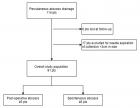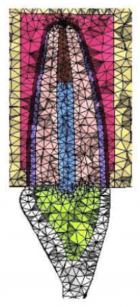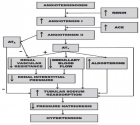Table of Contents
Stiff “Left Atrial” syndrome post-mustard procedure
Published on: 1st December, 2021
OCLC Number/Unique Identifier: 9359567131
Objectives: We describe the clinical course and management of two patients with post-capillary pulmonary hypertension due to diffuse pulmonary venous baffle calcification decades post-Mustard procedure.Background: From the late 1950s to the early 1990s, the definitive surgical repair for children with D-transposition of the great vessels (D-TGA) was an atrial switch procedure (either Senning or Mustard operation) which utilizes atrial-level baffles to shunt pulmonary venous blood to the morphologic right (systemic) ventricle and caval blood to the morphologic left (sub-pulmonary) ventricle. From a hemodynamic standpoint, baffle leaks and stenoses as well as precapillary pulmonary hypertension have all been described as both early and late complications [1]. Recently, delayed post-capillary pulmonary hypertension (in the absence of discrete baffle obstruction) decades post-atrial switch has also been described [2]. The underlying pathophysiology for this postcapillary pulmonary hypertension is unclear but is theorized to involve impaired diastology referable to the pulmonary venous baffle. Methods/Results: Using hemodynamic and imaging data, we describe two patients with extensive pulmonary venous baffle calcification and resultant pulmonary hypertension from the so-called “stiff left atrial (LA) syndrome.” This problem can be difficult to treat medically and is not amenable to catheter-based interventions. We hypothesize that this is an underlying mechanism for pulmonary hypertension in at least some post-Mustard and Senning patients. Conclusion: We describe the treatments and clinical course for each of these patients, and in particular describe how the surgical revision of the pulmonary venous baffle in one case led to the complete resolution of symptoms.
Mouth-to-mouth ventilation through cardiopulmonary resuscitation, is there any other way?
Published on: 29th November, 2021
OCLC Number/Unique Identifier: 9359436628
Objective: to provide and explore possibility of new idea that perform mouth-to-mouth ventilation through cardiopulmonary resuscitation. Methods: stage one was establishing the ventilation technique using cola bottles, stage two was measuring the tidal volume when different sized cola bottles were used. Result: the smallest sized cola bottle (500 ml) could also make obvious thorax rise in manikin CPR model. The tidal volume was 174.5 ± 9.1 ml, 220 ± 7.6 ml and 447 ± 15.9 ml respectively for 500 ml, 600 ml and 1.25 L cola bottles when using single hand performance. There were statistical differences (0.001) in tidal volume of different sized cola bottle by using one hand performance and two hands. Conclusion: Larger sized cola bottles (600 ml, 1.25 L) could be used as substitute ventilation technique for mouth-to-mouth ventilation in special circumnutates.
RV Function by cardiac magnetic resonance and its relationship to RV longitudinal strain and neutrophil/lymphocyte ratio in patients with acute inferior ST-segment elevation myocardial infarction undergoing primary percutaneous intervention
Published on: 23rd November, 2021
OCLC Number/Unique Identifier: 9359437609
Background: Although acute inferior myocardial infarction (MI) is usually regarded as being lower risk compared with acute anterior MI, right ventricular (RV) myocardial involvement (RVMI) may show an increased risk of cardiovascular (CV) morbidity and mortality in patients with inferior MI. CMR is ideal for assessing the RV because it allows comprehensive evaluation of cardiovascular morphology and physiology without most limitations that hinder alternative imaging modalities. Objectives: To evaluate the sensitivity of strain and strain rate of the RV using 2D speckle tracking echo and the neutrophil/ lymphocyte ratio (NLR) compared to cardiac MRI (CMR) as the gold standard among patients with inferior STEMI undergoing primary percutaneous coronary intervention (PCI). Methodology: 40 Patients with inferior MI who had primary PCI were included in the study; they were divided into two groups according to the RVEF using CMR. NLR was done in comparison to RVEF.Results: out of the 40 patients, 18 (45%) patients had RV dysfunction. 2D echocardiography was done for all patients, where fractional area change (FAC) in the RV dysfunction group appeared to be significantly reduced compared to the group without RV dysfunction (p value = 0.03). In addition, RV longitudinal strain (LS) by speckle tracking echo was reduced with an average of 19.5 ± 3.9% in the RV dysfunction group.Both CMR- derived RV SV, and EF were lower among the RV dysfunction group, (26.8 ± 15.8) ml and (35.4 ± 6.9)% respectively, with large RV systolic volume, with a highly statistically significant difference in comparison to the other group (p value = 0.000). Complications, heart block was significantly higher in patients with RV dysfunction (p value = 0.008) as it occurred in 5 (27.8%) patients.N/L ratio for predicting RV dysfunction by CMR had a cut-off value of > 7.7 with low sensitivity (38.8%) and high specificity (77.3 %). In contrast, LS for predicting RV dysfunction by CMR had high sensitivity (83.3%) and high specificity (63.6%) with p value = 0.005.Conclusion: Our results showed that RV dysfunction in inferior MI is better detected using cardiac magnetic resonance imaging. In inferior STEMI patients who underwent primary PCI, NLR has low sensitivity but high specificity for predicting RVD when measured by cardiac MRI.
Percutaneous treatment of severe retroperitoneal hematoma after percutaneous coronary intervention
Published on: 25th September, 2021
OCLC Number/Unique Identifier: 9272370670
We describe a patient who developed severe retroperitoneal and intraperitoneal bleeding complicating femoral arterial catheterization for Percutaneous coronary intervention. Balloon tamponade of the actively bleeding femoral artery was effective in sealing off the leakage.This management strategy for this problem emphasizing an anatomical based interventional approach if the patient does not stabilize with volume resuscitation.

HSPI: We're glad you're here. Please click "create a new Query" if you are a new visitor to our website and need further information from us.
If you are already a member of our network and need to keep track of any developments regarding a question you have already submitted, click "take me to my Query."

























































































































































